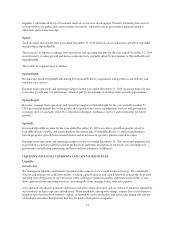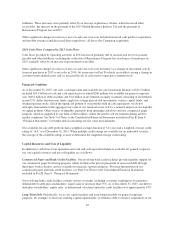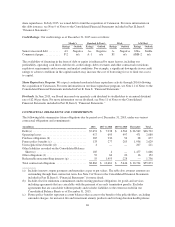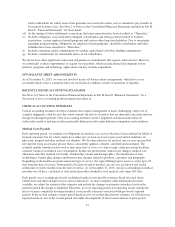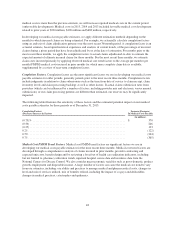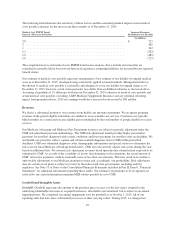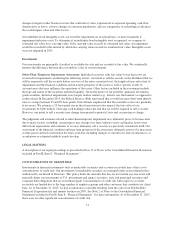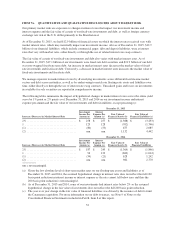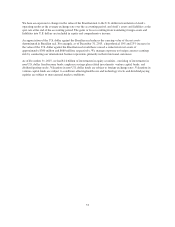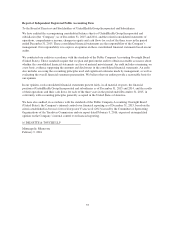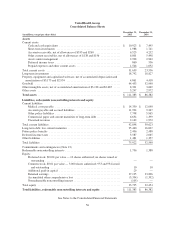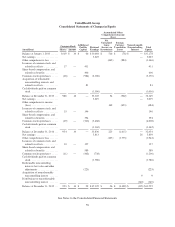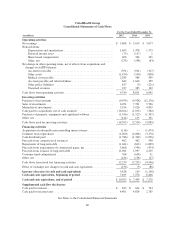United Healthcare 2015 Annual Report Download - page 53
Download and view the complete annual report
Please find page 53 of the 2015 United Healthcare annual report below. You can navigate through the pages in the report by either clicking on the pages listed below, or by using the keyword search tool below to find specific information within the annual report.changes in legal or other business factors that could affect value, experienced or expected operating cash-flow
deterioration or losses, adverse changes in customer populations, adverse competitive or technological advances
that could impact value and other factors.
Our indefinite-lived intangible assets are tested for impairment on an annual basis, or more frequently if
impairment indicators exist. To determine if an indefinite-lived intangible asset is impaired, we compare its
estimated fair value to its carrying value. If the carrying value exceeds its estimated fair value, an impairment
would be recorded for the amount by which the carrying value exceeds its estimated fair value. Intangible assets
were not impaired in 2015.
Investments
Our investments are principally classified as available-for-sale and are recorded at fair value. We continually
monitor the difference between the cost and fair value of our investments.
Other-Than-Temporary Impairment Assessment. Individual securities with fair values lower than costs are
reviewed for impairment considering the following factors: our intent to sell the security or the likelihood that we
will be required to sell the security before recovery of the entire amortized cost, the length of time and extent of
impairment and the financial condition and near-term prospects of the issuer as well as specific events or
circumstances that may influence the operations of the issuer. Other factors included in the assessment include
the type and nature of the securities and their liquidity. Given the nature of our portfolio, primarily investment
grade securities, historical impairments were largely market related (e.g., interest rate fluctuations) as opposed to
credit related. In December 2015, the Federal Reserve (Fed) announced that it would increase short-term interest
rates to a range between 25 and 50 basis points. Fed officials emphasized that they intend to raise rates gradually,
if necessary. We estimate a 25 basis point rise in short-term interest rates impacts the fair-value of our
investments by $200 million. Our large cash holdings reduce the risk that we will be required to sell a security.
However, our intent to sell a security may change from period to period if facts and circumstances change.
The judgments and estimates related to other-than-temporary impairment may ultimately prove to be inaccurate
due to many factors, including: circumstances may change over time, industry sector and market factors may
differ from expectations and estimates or we may ultimately sell a security we previously intended to hold. Our
assessment of the financial condition and near-term prospects of the issuer may ultimately prove to be inaccurate
as time passes and new information becomes available, including changes to current facts and circumstances, or
as unknown or estimated unlikely trends develop.
LEGAL MATTERS
A description of our legal proceedings is presented in Note 13 of Notes to the Consolidated Financial Statements
included in Part II, Item 8, “Financial Statements.”
CONCENTRATIONS OF CREDIT RISK
Investments in financial instruments such as marketable securities and accounts receivable may subject us to
concentrations of credit risk. Our investments in marketable securities are managed under an investment policy
authorized by our Board of Directors. This policy limits the amounts that may be invested in any one issuer and
generally limits our investments to U.S. government and agency securities, state and municipal securities and
corporate debt obligations that are investment grade. Concentrations of credit risk with respect to accounts
receivable are limited due to the large number of employer groups and other customers that constitute our client
base. As of December 31, 2015, we had a reinsurance receivable resulting from the sale of our Golden Rule
Financial Corporation life and annuity business in 2005. See Note 2 of Notes to the Consolidated Financial
Statements included in Part II, Item 8, “Financial Statements.” for more information. As of December 31, 2015,
there were no other significant concentrations of credit risk.
51




